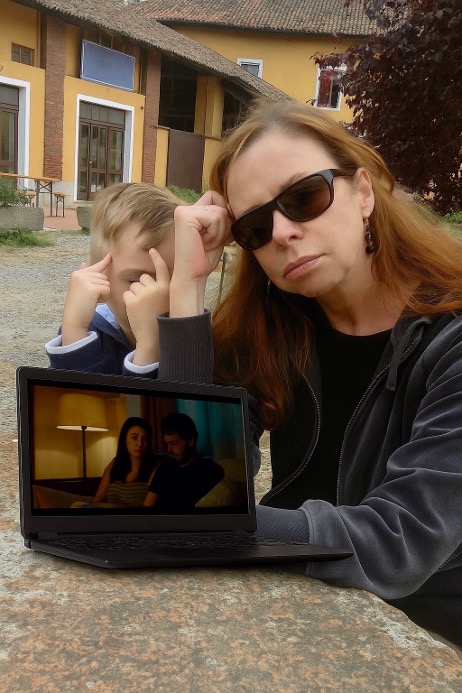Media Diet

Image courtesy of SG. "Live semiotic analysis. The film: 0. The off-screen signs: 10."
A series exploring the media “input” of a group of people — our commercial semiotician colleagues, from around the world — whose “output” we admire.
Milan…
SEMIOVOX
What’s the best movie you’ve seen recently?
STEFANIA GOGNA
The most powerful film I’ve seen recently is The Zone of Interest by Jonathan Glazer. It’s not an easy watch and maybe that’s exactly why it stayed with me so strongly. It tells the story of the Holocaust… without ever really showing it. Everything remains off-screen. What we do see is the almost boring everyday life of the Höss family, living next door to Auschwitz: neatly kept gardens, children playing, afternoon tea. And in the background: Screams. Gunshots. Ash falling from the sky.
That contrast between what’s visible and what’s merely heard is where the film hits the hardest.
As a movie addict, I’m drawn to these “loaded absences”, where what’s left out often says more than what’s shown. The film captures how normality can become complicit with evil, how indifference can be structural. It doesn’t shout, but it unsettles. And it lingers, like a tension you can’t quite shake off. It’s a sensory experience but also a deeply political one.
SEMIOVOX
What’s the best TV series you’ve seen recently?
STEFANIA GOGNA
I thought about mentioning Adolescence, but honestly, I’ve seen it come up a lot already, maybe too much. So I’d rather go with Beef (Netflix). I didn’t expect much from it at first, and then it just… stuck with me.
It starts with a stupid little road-rage thing, nothing dramatic, but somehow it opens up this whole mess of stuff: anger, guilt, pride, shame, loneliness. I kept thinking, Wow, this is exactly the kind of emotional overload nobody talks about but everyone’s carrying around.
What really hit me was how well it captures that burnout feeling, like you’re always performing, smiling, holding it together, but no one really sees you. And then boom, something cracks. The show doesn’t explain that; it just shows it.
There’s so much going on in the background too: church references, family pressure, little visual cues that say more than the dialogue. Some scenes are just weird and beautiful and uncomfortable all at once.
To me, it feels like a show made for this messy moment, post-everything, kind of all over the place, like we are.
SEMIOVOX
Any other media inputs you’d like to mention?
STEFANIA GOGNA
An ongoing media input I return to again and again, nearly ritualistically, is podcasts. Not the fancy, narrative, “broadcast-quality” ones, though, but the lo-fi, conversational ones, too, when people think out loud.
I listen while walking, while I cook, while I travel, as though I have a stream of consciousness always running parallel to me.
My favourite thing about podcasts is the way they afford unstructured meaning-formation: a guest might say, oh, something entirely peripheral, which opens a whole new way of seeing things for me.
I enjoy shows wherein culture, philosophy, and daily life all commingle, the kind wherein higher theory and memes are merged. It’s here, in these liminal areas, wherein I receive the best number of revealing shifts people are undergoing in the ways they think, how they feel, and what they say.
As a semiotician, it’s a treasure trove: raw language, emotional subtext, shifting codes, all real-time, in voice.
MEDIA DIET: GIANLLUCA SIMI (Brazil) | HIBATO BEN AHMED (France) | MARIE LENA TUPOT (USA) | EUGENE GORNY (Thailand) | YOGI HENDLIN (Netherlands / USA) | INKA CROSSWAITE (Germany / South Africa) | SÓNIA MARQUES (Portugal) | ĽUDMILA LACKOVÁ BENNETT (Czechia) | BRIAN KHUMALO (USA / South Africa) | JIAKUN WANG (Shanghai) | FRANCISCO HAUSS (China / Mexico) | ASHLEY MAURITZEN (England) | STEFANIA GOGNA (Italy) | BECKS COLLINS (England) | ANTJE WEISSENBORN (Germany) | MARIANE CARA (Brazil) | MARTHA ARANGO (Sweden) | PAULINA GOCH-KENAWY (Poland) | COCO WU (Singapore / China) | JOSH GLENN (USA) | JENNIFER VASILACHE (Switzerland) | ANDREA BASUNTI (England) | SARAH JOHNSON (Canada) | MARIA PAPANTHYMOU (Greece) | VICTORIA GERSTMAN (Scotland).
Also see these global semio series: MAKING SENSE (Q&As) | SEMIOFEST SESSIONS (monthly mini-conferences) | COVID CODES | SEMIO OBJECTS | COLOR CODEX | DECODER (fictional semioticians) | CASE FILE | PHOTO OP | MEDIA DIET | TATTOO YOU (semioticians’ tattoos).

